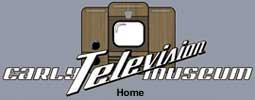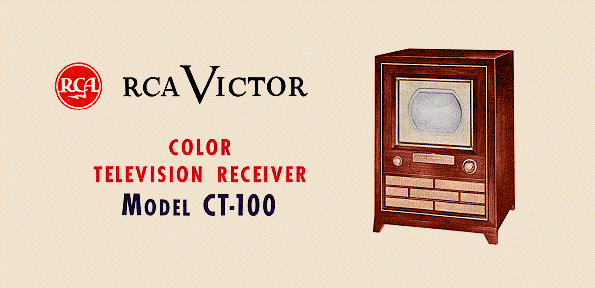Ed Reitan's Color Television History
CT-100 Color Receiver (CTC-2 Chassis, 1954)(Red Mahogany grained finish, retail: $1000)
Starting March 25, 1954, 5,000 CT-100's were manufactured in RCA's Bloomington, Indiana plant. The set was named, "The Merrill". By mid-April of 1954, the sets were available at dealers. RCA released the CT-100's service literature, "1954 No. T3", on March 31, 1954. RCA also published a Television Service Clinic booklet, "Principles of Color Television and Technical Features of the RCA Victor Model CT-100 Color Television Receiver". This excellent 55 page booklet also covers purity and convergence adjustments. There is a reason for the amazing Technicolor-like picture of the CT-100. The CT-100's shadow mask CRT used color phosphors with correct chromaticity corresponding to the NTSC standard. The red and green of the CT-100 is more rich and saturated than the orange-red and yellow-green of modern sets. This results in the larger color gamut of the CT-100. The CT-100's 15GP22 color kinescope provided a rounded side 11 1/2-inch wide by 8 5/8-inch high picture with an area of approximately 100 square inches. A planar shadow mask and flat phosphor screen with decorative mask were suspended inside the round glass envelope. CBS Hytron would later develop the technique to manufacture a curved shadow mask and to deposit color phosphor dots directly on the inside of the face plate. With its 45-degree deflection angle the CRT was 26-inches long. The 15GP22 used electrostatic convergence and required external customer static convergence and focus adjustment knobs on the left side of the cabinet. The CT-100, with a 16-position turret tuner, could receive any combination of VHF and UHF channels and provided a 45.75 MHz picture and 41.25 MHz sound IF output. Seven IF stages were used to minimize amplitude and phase distortion over the 4.5 MHz bandwidth. A conventional horizontal "SynchroGuide" provided horizontal sync and drove a 6CD6 output tube. The high voltage power provided 19,500 volts to the CRT by use of a 3A3 rectifier and 6BD4 shunt regulator. The set consumed 475 watts. The CT-100 is one of the few consumer receivers to utilize the full color capability of the NTSC signal. The CT-100's complex 36 tube chassis, numbered "CTC-2", used wide-band I and Q color demodulation for higher color resolution. Synchronous low level 1.5 MHz I demodulation and 0.5 MHz Q demodulation and phase splitting derived red, blue, and green signals by I, Q, and Y matrixing methods. It is ironic that 45 years after the introduction of this set, there is still little use by modern receivers of the orange-cyan visual acuity information in the NTSC color signal. Color synchronization was achieved by a conventional AFC circuit with a phase detector and reactance control of a crystal oscillator. The CT-100's color quality is indeed amazing when seen on one of today's few remaining operational sets. The set retailed for $1,000. When the 21-inch 21-CT-55 was introduced in December of 1954, the price for the many unsold CT-100 sets was reduced to $495. The CT-100 photo is from its original service manual. Don Kent did the PhotoShop colorization of this image.
V1.00 03-14-1999 Copyright 1999, Ed Reitan
|

